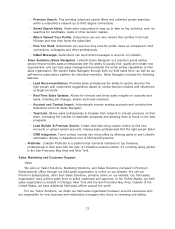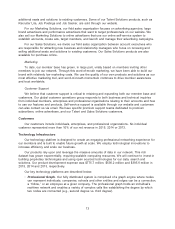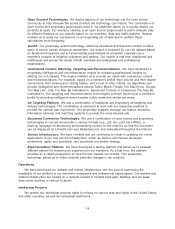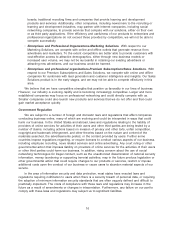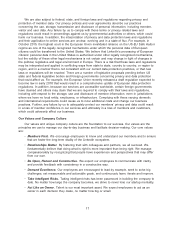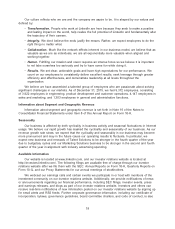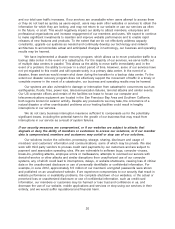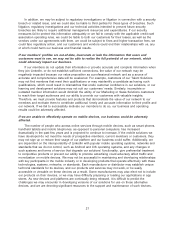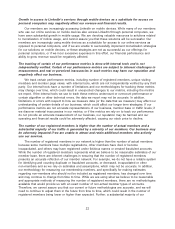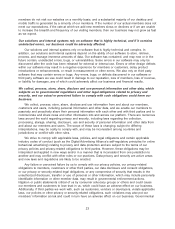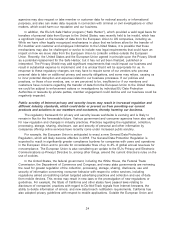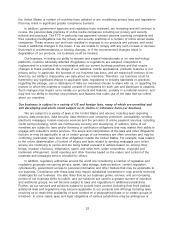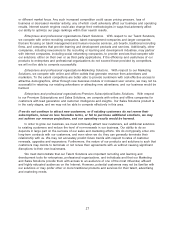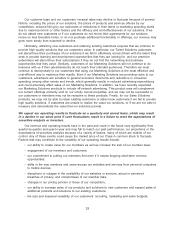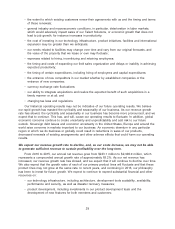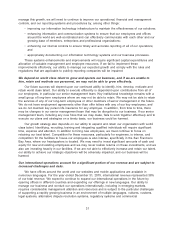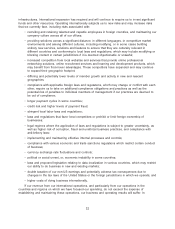LinkedIn 2015 Annual Report Download - page 24
Download and view the complete annual report
Please find page 24 of the 2015 LinkedIn annual report below. You can navigate through the pages in the report by either clicking on the pages listed below, or by using the keyword search tool below to find specific information within the annual report.Growth in access to LinkedIn’s services through mobile devices as a substitute for access on
personal computers may negatively affect our revenue and financial results.
Our members are increasingly accessing LinkedIn on mobile devices. While many of our members
who use our online services on mobile devices also access LinkedIn through personal computers, we
have seen substantial growth in mobile usage. We are devoting valuable resources to solutions related
to monetization of mobile usage, and cannot assure you that these solutions will be successful. Our
members are increasingly using mobile devices as a substitute for access to our online services as
opposed to personal computers, and if we are unable to successfully implement monetization strategies
for our solutions on mobile devices, or these strategies are not as successful as our offerings for
personal computers, or if we incur excessive expenses in this effort, our financial performance and
ability to grow revenue would be negatively affected.
The tracking of certain of our performance metrics is done with internal tools and is not
independently verified. Certain of our performance metrics are subject to inherent challenges in
measurement, and real or perceived inaccuracies in such metrics may harm our reputation and
negatively affect our business.
We track certain performance metrics, including number of registered members, unique visiting
members and member page views, with internal tools, which are not independently verified by any third
party. Our internal tools have a number of limitations and our methodologies for tracking these metrics
may change over time, which could result in unexpected changes to our metrics, including the metrics
we report. If the internal tools we use to track these metrics undercount or overcount performance or
contain algorithm or other technical errors, the data we report may not be accurate. In addition,
limitations or errors with respect to how we measure data (or the data that we measure) may affect our
understanding of certain details of our business, which could affect our longer term strategies. If our
performance metrics are not accurate representations of our business, member base or traffic levels; if
we discover material inaccuracies in our metrics; or if the metrics we rely on to track our performance
do not provide an accurate measurement of our business, our reputation may be harmed and our
operating and financial results could be adversely affected, causing our stock price to decline.
The number of our registered members is higher than the number of actual members and a
substantial majority of our traffic is generated by a minority of our members. Our business may
be adversely impacted if we are unable to attract and retain additional members who actively
use our services.
The number of registered members in our network is higher than the number of actual members
because some members have multiple registrations, other members have died or become
incapacitated, and others may have registered under fictitious names or created fraudulent accounts.
While the number of registered members represents what we believe to be reasonable estimates of our
member base, there are inherent challenges in ensuring that the number of registered members
presents an accurate reflection of our member network. For example, we do not have a reliable system
for identifying and counting duplicate or fraudulent accounts, or deceased, incapacitated or other
non-members and so we rely on estimates and assumptions, which may not be accurate. In addition,
our methodology for measuring our membership numbers, and specifically for making estimates
regarding non-members who should not be included as registered members, has changed over time
and may continue to change from time to time. While we are using what we believe to be reasonable
and appropriate methods of measuring the number of registered members, there are no methodologies
available that would provide us with an exact number of non-actual member types of accounts.
Therefore, we cannot assure you that our current or future methodologies are accurate, and we will
need to continue to adjust them in the future from time to time, which could result in the number of
registered members being lower or higher than expected. Further, a substantial majority of our
22


